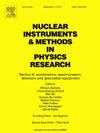Filter stack spectrometer measurements of high energy x-ray sources for radiography
IF 1.5
3区 物理与天体物理
Q3 INSTRUMENTS & INSTRUMENTATION
Nuclear Instruments & Methods in Physics Research Section A-accelerators Spectrometers Detectors and Associated Equipment
Pub Date : 2025-04-03
DOI:10.1016/j.nima.2025.170465
引用次数: 0
Abstract
Analyzing the spectra of MeV x-rays verifies the consistency of radiographic systems and provides a standardized way to compare outputs from different sources, such as traditional accelerator-based systems and newer laser-based systems. A stack of alternating image plates and filters, known as a Filter Stack Spectrometer (FSS), has been fielded at three x-ray sources: the Dual Axis Radiographic Hydrodynamic Test (DARHT) facility, the X5000 commercial x-ray cabinet, and the Texas Petawatt laser. On the radiographic sources tested, varying salient parameters such as electron energy and target material changes the output MeV x-ray spectra. This diagnostic, configured with a spectral range of 50 keV–35 MeV, is evaluated via a novel inversion routine insensitive to assumed spectral shape. This insensitivity to spectral shape is essential for measuring spectra of sources that are difficult to predict with radiation transport models, such as multi-pulse accelerators and laser-driven sources. Radiation transport calculations representative of the DARHT experiment, which is straightforward to model, show good agreement between simulated and measured spectra. Future improvements to the FSS, such as replacing time-integrated image plates with scintillators, are also discussed.
射线照相用高能x射线源的滤波叠加光谱仪测量
分析MeV x射线的光谱验证了射线照相系统的一致性,并提供了一种标准化的方法来比较不同来源的输出,例如传统的基于加速器的系统和较新的基于激光的系统。一堆交替成像板和过滤器,被称为过滤器堆栈光谱仪(FSS),已经在三个x射线源上部署:双轴射线照相流体动力测试(DARHT)设施,X5000商用x射线柜和德克萨斯petwaw激光器。在测试的射线源上,电子能量和目标材料等显著参数的变化会改变输出的MeV x射线光谱。该诊断配置的光谱范围为50kv - 35mev,通过一种对假设光谱形状不敏感的新型反演程序进行评估。这种对光谱形状的不敏感对于测量难以用辐射输运模型预测的源的光谱是必不可少的,例如多脉冲加速器和激光驱动源。以DARHT实验为代表的辐射输运计算结果表明,模拟光谱与实测光谱之间的一致性较好。对FSS未来的改进,如用闪烁体代替时间积分成像板,也进行了讨论。
本文章由计算机程序翻译,如有差异,请以英文原文为准。
求助全文
约1分钟内获得全文
求助全文
来源期刊
CiteScore
3.20
自引率
21.40%
发文量
787
审稿时长
1 months
期刊介绍:
Section A of Nuclear Instruments and Methods in Physics Research publishes papers on design, manufacturing and performance of scientific instruments with an emphasis on large scale facilities. This includes the development of particle accelerators, ion sources, beam transport systems and target arrangements as well as the use of secondary phenomena such as synchrotron radiation and free electron lasers. It also includes all types of instrumentation for the detection and spectrometry of radiations from high energy processes and nuclear decays, as well as instrumentation for experiments at nuclear reactors. Specialized electronics for nuclear and other types of spectrometry as well as computerization of measurements and control systems in this area also find their place in the A section.
Theoretical as well as experimental papers are accepted.

 求助内容:
求助内容: 应助结果提醒方式:
应助结果提醒方式:


